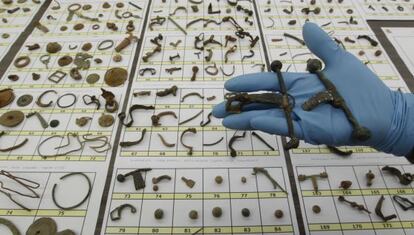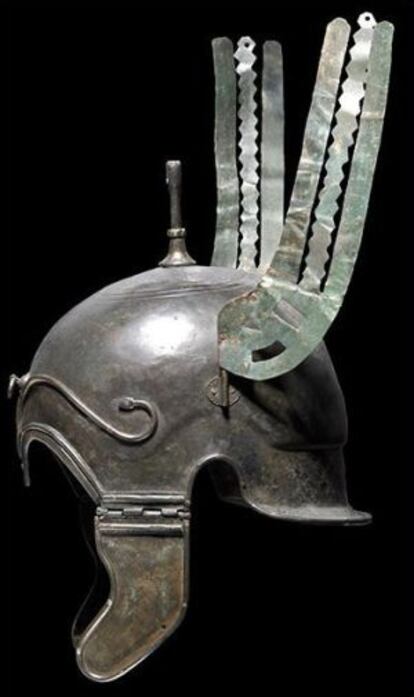No price to pay for pillaging
Few cases of archeological theft ever make it to court, the Civil Guard says

The man was lying on the floor, playing dead. A heart attack had apparently got him - or at least that's what he screamed out before collapsing on the floor. But when the ambulance arrived, the diagnosis changed somewhat. "What you've got is the Civil Guard in your house," the ambulance crew told him.
The anecdote is told by an officer from the Civil Guard's Historical Heritage Group, which carried out a search of the cardiac arrest "victim's" house. Rather than his health, he was facing another problem: how to explain the old coins, the metal detector and the other suspicious artifacts that were piled up in his property.
The Civil Guard team recovered more than 9,000 archeological pieces during the operation, which was dubbed "Necrópolis," and led to 12 arrests for alleged plundering. The officers even managed to take photographs of the pillagers as they bragged about their hauls in a bar. And what was the punishment handed down to them by the courts? Nothing.
There are very few sentences, very few. But there are a lot of dismissals"
Nor, for the moment, has the retired man arrested in March as part of "Operation Helmet" faced any punishment, despite having allegedly stolen 4,000 Celtiberian pieces in Aragon. In fact, the majority of the 300 to 500 complaints filed each year with the authorities for pillaging never result in any kind of sentences for the culprits. Although the statistics for 2013 are yet to be completed, it is already looking like one of the worst years for the crime, the most recent example of which hit the headlines last week, with the arrest of two people accused of plundering the Tiermes archeological site in Soria province.
"There are very few sentences, very few," explains Ana María Yañez, a lawyer specializing in heritage and a lecturer at Madrid's Complutense University. "But there are a lot of dismissals." So many, that in some cases the pieces are even returned to the alleged looter.
One of the reasons for this lies with the demands of the judges. Archeological offenses are not like a game of Cluedo - it's not enough to simply find the murder weapon and the guilty person. The origin of each piece must be proven, as well as the moment that the pillaging took place - otherwise, a court case will not go anywhere.
"Right now, with the resources we have to hand, it's impossible for us to prosecute," explains the civil guard who told the anecdote about the heart attack "victim." "We have monitored a lot of people and we have had to drop the cases. They are crooked, but we can't prove it."

The Civil Guard has, in fact, managed to identify 1,500 people, among whom 200 are repeat offenders. As the officer speaks, he is scrolling through photos and videos of men with metal detectors on his computer screen. The evidence is the result of hours and hours of spying on them as they work. And there are plenty of anecdotes to choose from. For example, the advert written by one pillager eager to sell his finds: "I have a tomb tartesica. For sale. I am sorry. My inglis is very beed [sic]," the text read.
When the suspects have finished the job at hand, the Civil Guard arrives to inspect the scene, sometimes returning with an archeologist to determine whether the site is of archeological value and to evaluate the damage caused. That's not to say, however, that they can easily identify what has been taken. "Archeological heritage is usually hidden," explains Yáñez. "And its disappearance is not usually noticed."
"A lot of the time a judge decides that the pillager does not know the value of what he has taken," explains Carmen Acedo, a public prosecutor. Even more so if, as is often the case, the site was an enigma for the authorities themselves.
The profile of the enemy, however, is well known. "They are always the same," explains a civil guard captain. "They destroy the site and take whatever is valuable for them. They move in groups, travel far from home and usually act on weekdays." And they take with them ground-penetrating radar equipment, and other technologies worthy of any modern-day Indiana Jones.
The Civil Guard is keen to see the creation of pillaging as a criminal offense. Currently, the activity is not included in the penal code. As such, the authorities have to seek prosecution for other crimes, such as criminal damage and dealing in contraband.
And there lies, the experts say, the other ally of the pillagers. "We need to see our heritage as something that belongs to all of us," explains Carmen Marcos, the deputy director of the National Archeological Museum.
"The big challenge is educating people about the problem, which is the best form of prevention," explains Elisa de Cabo de la Vega, the deputy director of the state National Heritage department. That means more information, more complaints, and more attention from the authorities and citizens. Put like that, it sounds easy. But would it be enough? Who knows - after all, real life isn't like a game of Cluedo...
Tu suscripción se está usando en otro dispositivo
¿Quieres añadir otro usuario a tu suscripción?
Si continúas leyendo en este dispositivo, no se podrá leer en el otro.
FlechaTu suscripción se está usando en otro dispositivo y solo puedes acceder a EL PAÍS desde un dispositivo a la vez.
Si quieres compartir tu cuenta, cambia tu suscripción a la modalidad Premium, así podrás añadir otro usuario. Cada uno accederá con su propia cuenta de email, lo que os permitirá personalizar vuestra experiencia en EL PAÍS.
¿Tienes una suscripción de empresa? Accede aquí para contratar más cuentas.
En el caso de no saber quién está usando tu cuenta, te recomendamos cambiar tu contraseña aquí.
Si decides continuar compartiendo tu cuenta, este mensaje se mostrará en tu dispositivo y en el de la otra persona que está usando tu cuenta de forma indefinida, afectando a tu experiencia de lectura. Puedes consultar aquí los términos y condiciones de la suscripción digital.
Últimas noticias
Pinochet’s victims grapple with José Antonio Kast’s rise in Chile
Reinhard Genzel, Nobel laureate in physics: ‘One-minute videos will never give you the truth’
How Japan is trying to avert ‘digital defeat’
The complicated life of Francesca Albanese: A rising figure in Italy but barred from every bank by Trump’s sanctions
Most viewed
- Pablo Escobar’s hippos: A serious environmental problem, 40 years on
- Why we lost the habit of sleeping in two segments and how that changed our sense of time
- Charles Dubouloz, mountaineering star, retires at 36 with a farewell tour inspired by Walter Bonatti
- Trump’s obsession with putting his name on everything is unprecedented in the United States
- The Florida Keys tourist paradise is besieged by immigration agents: ‘We’ve never seen anything like this’









































